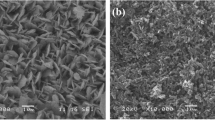Abstract
Polyaniline-modified carbon nanofibers were prepared in the presence of five different dopant acids, namely toluene sulfonic acid (TSA), hydrochloric acid (HCl), sulfuric acid (H2SO4), phosphoric acid (H3PO4) and camphor sulfonic acid (CSA), by oxidative polymerization. A comparative study on the effect of various types of dopants on the properties of PANI/CNF composite was performed. The electrical, dielectric and thermal properties of PANI/CNF composites were studied in contrast to pure PANI. Unlike polyaniline, all polyaniline/carbon nanofiber combination resulted in enhanced electrical and dielectric properties. Higher conductivity and thermal dependence of DC conductivity were obtained for toluene sulfonic acid-doped composite. UV–Vis analysis of the composites showed that the appreciable increase in conductivity of TSA-doped PANI/CNF composite is due to the extensive electron transfer. Further, thermogravimetric analysis showed improved thermal stability compared to PANI. A significant improvement is observed for organic acid-doped composites which suggest the presence of strong interaction between π orbitals of CNF and the quinoid rings of PANI. Hence, the study indicated that the dopants had a remarkable effect on the properties of PANI/CNF composites.









Similar content being viewed by others
References
Feast WJ, Tsibouklis J, Pouwer KL, Groenendaal L, Meijer EW (1996) Synthesis, processing and material properties of conjugated polymers. Polymer 37:5017–5047
Syed AA, Dinesan MK (1991) Review: polyaniline—a novel polymeric material. Talanta 38:815–837
Park SM, Lee HJ (2005) Recent advances in electrochemical studies of π-conjugated polymers. Bull Korean Chem Soc 26:697–706
Cortes MT, Sierra EV (2006) Effect of synthesis parameters in polyaniline: influence on yield and thermal behavior. Polym Bull 56:37–45
Pron A, Genoud F, Menardo C, Nechtschein M (1988) The effect of the oxidation conditions on the chemical polymerization of polyaniline. Synth Met 24:193–201
Kulkarni VG, Campbell LD, Mathew WR (1989) Thermal stability of polyaniline. Synth Met 30:321–325
Kahol PK, Satheesh Kumar KK, Geetha S, Trivedi DC (2003) Effect of dopants on electron localization length in polyaniline. Synth Met 139:191–200
Yang S, Chen W, You K (1997) The properties of polyaniline–polyelectrolyte complexes. Synth Met 84:77–78
Li S, Cao Y, Xue Z (1987) Soluble polyaniline. Synth Met 20:141–149
Shannon K, Fernandez J (1994) Preparation and properties of water-soluble, poly(styrenesulfonic acid)-doped polyaniline. J Chem Soc Chem Commun 5:643–644
Tazou K, Gregory RV (1993) A method to prepare soluble polyaniline salt solutions—in situ doping of PANI base with organic dopants in polar solvents. Synth Met 53:365–377
Sinha S, Bhadra S, Khastgir D (2009) Effect of dopant type on the properties of polyaniline. J Appl Polym Sci 112:3135–3140
Levon K, Ho KH, Zheng WY, Laakso J, Karna T, Taka T, Osterholm JE (1995) Thermal doping of polyaniline with dodecylbenzene sulfonic acid without auxiliary solvents. Polymer 36:2733–2738
Bhadra S, Khastgir D, Sinha NK, Lee JH (2009) Progress in preparation, processing and applications of polyaniline. Prog Polym Sci 34:783–810
Maser WK, Benito AM, Callejas MA, Seeger T, Martı́nez MT, Schreiber J, Muszynski J, Chauvet O, Osváth Z, Koós AA, Biró LP (2003) Synthesis and characterization of new polyaniline/nanotube composites. Mater Sci Eng 23:87–91
Cochet M, Maser WK, Benito AM, Callejas MA, Martinez MT, Benoit J, Schreiber J, Chauvet O (2001) Synthesis of a new polyaniline/nanotube composite: “in situ” polymerisation and charge transfer through site-selective interaction. Chem Commun 16:1450–1451
Paligová M, Vilčáková J, Sáha P, Křesálek V, Stejskal J, Quadrat O (2004) Electromagnetic shielding of epoxy resin composites containing carbon fibers coated with polyaniline base. Phys A 335:421
Dong H, Prasad S, Nayme V, Wayne EJ (2004) Sub-micrometer conducting polyaniline tubes prepared from polymer fiber templates. Chem Mater 16:371–373
Li Y, Wang J, Li X, Liu J, Geng D, Yang J, Li R, Sun X (2011) Nitrogen-doped carbon nanotubes as cathode for lithium–air batteries. Electrochem Commun 13:668–672
Lim S, Yoon SH, Mochida I, Jung DH (2009) Direct synthesis and structural analysis of nitrogen-doped carbon nanofibers. Langmuir 25:8268–8273
Chan HSO, Ng SC, Sim WS, Seow SH, Tan KL, Tan BTG (1993) Synthesis and characterization of conducting poly(o-aminobenzyl alcohol) and its copolymers with aniline. Macromolecules 26:144–150
Guo Y, Zhou Y (2007) Polyaniline nanofibers fabricated by electrochemical polymerization: a mechanistic study. Eur Polym J 43:2292–2297
Sedenkove I, Trchova M, Blinova NV, Stejskal J (2006) In-situ polymerized polyaniline films. Preparation in solutions of hydrochloric, sulfuric, or phosphoric acid. Thin Solid Films 515:1640–1646
Kuramoto N, Genies EM (1995) Micellar chemical polymerization of aniline. Synth Met 68:191–194
Zhang L (2007) The electrocatalytic oxidation of ascorbic acid on polyaniline film synthesized in the presence of β-naphthalenesulfonic acid. Electrochim Acta 52:6969–6975
Fu Y, Weiss RA (1997) Protonation of polyaniline with lightly sulfonated polystyrene. Synth Met 84:103–104
Koul S, Chandra R, Dhawan SK (2000) Conducting polyaniline composite for ESD and EMI at 101 GHz. Polymer 41:9305–9310
Ghosh P, Siddhanta SK, RejaulHaque S, Chakrabarti A (2001) Stable polyaniline dispersions prepared in nonaqueous medium: synthesis and characterization. Synth Met 123:83–89
Zengin H (2002) Carbon nanotube doped polyaniline. Adv Mater 14:1480–1483
Hopkins AR, Rasmussen PG, Basheer RA (1996) Characterization of solution and solid state properties of undoped and doped polyanilines processed from hexafluoro-2-propanol. Macromolecules 29:7838–7846
Mathew H, Punnackal VS, Kuriakose S, Kumari BS (2013) Synthesis and electrical characterization of polyaniline-multiwalled carbon nanotube composites with different dopants. A. Manuel, IJSRP, 3, 1
Pron A, Rannou P (2002) Processible conjugated polymers: from organic semiconductors to organic metals and superconductors. Prog Polym Sci 27:135–190
Dang ZM, Wang L, Yin Y, Zhang Q, Lei QQ (2007) Giant dielectric permittivities in functionalized carbon-nanotube/electroactive-polymer nanocomposites. Adv Mater 19:852–857
He F, Lau S, Chan HL, Fan JT (2009) High dielectric permittivity and low percolation threshold in nanocomposites based on poly(vinylidene fluoride) and exfoliated graphite nanoplates. Adv Mater 21:710–715
Author information
Authors and Affiliations
Corresponding author
Rights and permissions
About this article
Cite this article
Anju, V.P., Narayanankutty, S.K. Effect of dopant on the properties of polyaniline/carbon nanofiber composites. Polym. Bull. 76, 5253–5267 (2019). https://doi.org/10.1007/s00289-018-2649-7
Received:
Revised:
Accepted:
Published:
Issue Date:
DOI: https://doi.org/10.1007/s00289-018-2649-7




